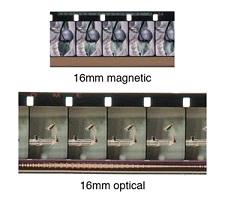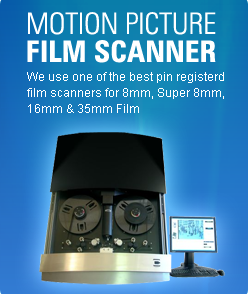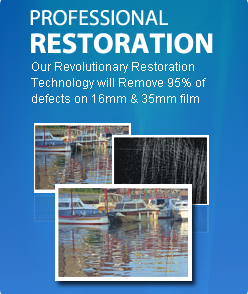
Regular 8mm movie film was never sold commercially with a sound strip but some people did attach a sound strip themselves. Super 8 film has the option but you had to buy the film with the sound strip on it and you had to have a sound camera and microphone. 16mm had both magnetic and optical. On the order form you can let us know if you think your film has sound on it. It does take extra effort to capture the sound and incorporate it into the requested formats. So, we do charge a little more for sound film.
We can not capture any digital audio like Dolby Digital or Sony Dynamic Digital Sound.


The above picture is just an example. 16mm sound film came in many different varieties. 16mm film with optical sound will have sprocket holes on 1 side. The other side will carry the audio track.
There is no sound on Regular 8 film. At least it wasn't produced that way. There were some people that put a magnetic sound strip on 8mm film themselves. There was also some test 8mm film with sound that Kodak used to prepare for Super 8 film.
Even though Super 8 film was sold in two versions, sound and silent, most Super 8 film is silent. Only about 5% of all Super 8 movie film has sound on it.
Super 8 sound could be recorded with a microphone during filming or could also be recorded using a projector when the film played. The quality of the sound varied widely.
Bensalem Fun Facts: The township is situated along the Delaware River and includes numerous distinct communities. The city is home to the headquarters of Charming Shoppes, a Fortune 1000 company. Four major transportation arteries run through Bensalem. The region features numerous historic buildings, notable covered bridges and picturesque scenery.
Pennsylvania Fun Facts: One of the original 13 colonies, Pennsylvania was founded by William Penn as a haven for his fellow Quakers. Pennsylvania’s capital, Philadelphia, was the site of the first and second Continental Congresses in 1774 and 1775, the latter of which produced the Declaration of Independence, sparking the American Revolution. After the war, Pennsylvania became the second state, after Delaware, to ratify the U.S. Constitution.





